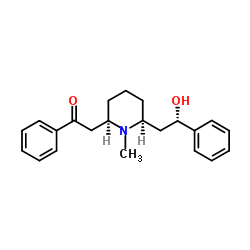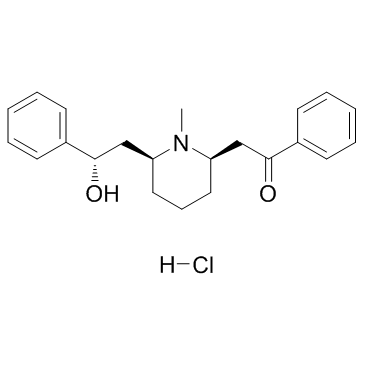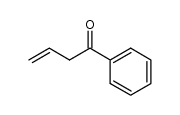洛贝林
更新时间:2025-08-23 19:09:53

洛贝林结构式

|
常用名 | 洛贝林 | 英文名 | (-)-Lobeline |
|---|---|---|---|---|
| CAS号 | 90-69-7 | 分子量 | 337.455 | |
| 密度 | 1.1±0.1 g/cm3 | 沸点 | 485.6±15.0 °C at 760 mmHg | |
| 分子式 | C22H27NO2 | 熔点 | 130-131° | |
| MSDS | N/A | 闪点 | 247.5±20.4 °C |
洛贝林用途洛贝林(α-洛贝林;L-洛贝林)是一种亲脂性生物碱,是一种烟碱受体激动剂。洛贝林抑制d-甲基苯丙胺自我给药,无多巴胺毒性。洛贝琳挽救了滥用d-苯丙胺导致的成瘾效应。洛贝林通过抑制DA摄取到突触小泡中并改变突触前DA储存来增加多巴胺(DA)释放[1][2][3]。 |
| 中文名 | 洛贝林 |
|---|---|
| 英文名 | (-)-lobeline |
| 英文别名 | 更多 |
| 描述 | 洛贝林(α-洛贝林;L-洛贝林)是一种亲脂性生物碱,是一种烟碱受体激动剂。洛贝林抑制d-甲基苯丙胺自我给药,无多巴胺毒性。洛贝琳挽救了滥用d-苯丙胺导致的成瘾效应。洛贝林通过抑制DA摄取到突触小泡中并改变突触前DA储存来增加多巴胺(DA)释放[1][2][3]。 |
|---|---|
| 相关类别 | |
| 体外研究 | 洛贝林(0.1-100μM)诱导 [3H]天溢出呈非钙依赖性[1]。 洛贝琳牌手表抑制 [3H]天被突触小体 (IC50=80μM)和囊泡 (IC50=0.88μM)摄取[1]。 洛贝林(0.1-1μM;1小时)抑制 1μM d-甲基苯丙胺诱导的纹状体切片释放多巴胺[2]。 |
| 体内研究 | 洛贝林(0.3-3.0 mg/kg;皮下注射; 单剂量) 降低模型大鼠 d-去氧麻黄碱的自我给药能力[3]。 洛贝林(3 mg/kg;皮下注射; 7.个周期,共 7.次) 以非竞争性的方式特别降低大鼠对 d-去氧麻黄碱的反应,并增加耐受性发展[3]。 动物模型:Sprague-Dawley大鼠(200-250 g)[3]剂量:0.3 mg/kg、1.0 mg/kg和3.0 mg/kg用于急性给药;慢性给药3 mg/kg给药:皮下注射;测量前15分钟,或每15分钟进行7次;间隔2个干预维持日的d-甲基苯丙胺(0.05 mg/kg输注)自我给药结果:d-甲基苯甲酯自我给药减少。 |
| 参考文献 |
| 密度 | 1.1±0.1 g/cm3 |
|---|---|
| 沸点 | 485.6±15.0 °C at 760 mmHg |
| 熔点 | 130-131° |
| 分子式 | C22H27NO2 |
| 分子量 | 337.455 |
| 闪点 | 247.5±20.4 °C |
| 精确质量 | 337.204193 |
| PSA | 40.54000 |
| LogP | 3.61 |
| 蒸汽压 | 0.0±1.3 mmHg at 25°C |
| 折射率 | 1.563 |
| 储存条件 | 库房低温通风干燥,与食品原料分开存放 |
|
Date Updated: 13/FEB/2006
Version 1.2 Regulation (EC) No 1907/2006 ________________________________________________________________________ 1 - Product and Company Information ________________________________________________________________________ Product NameL-LOBELINE FREE BASE
Product NumberL7149 Company Century Ba-Shi Building 22A-B, 200020 Shanghai Technical Phone #86-21-61415566 Fax 86-21-61415567 E-mail Address ________________________________________________________________________ 2 - Hazards Identification ________________________________________________________________________ SPECIAL INDICATION OF HAZARDS TO HUMANS AND THE ENVIRONMENT Toxic by inhalation, in contact with skin and if swallowed. ________________________________________________________________________ 3 - Composition/Information on Ingredients ________________________________________________________________________ Product NameCAS #EC noAnnex I Index Number L-LOBELINE FREE BASE90-69-7202-012-3 None FormulaC22H27NO2 Molecular Weight 337,5000 AMU Synonyms8,10-Diphenyllobelionol * 2-(6-(beta-Hydroxy-phenethyl)-1-methyl-2-piperidy l)acetophenone * 2-(6-(2-Hydroxy-2-phenylethyl)-1-methyl-2-piperid inyl)-1-phenylethanone * Inflatine * Lobelin * (-)-Lobeline * alpha-Lobeline * Lobnico ________________________________________________________________________ 4 - First Aid Measures ________________________________________________________________________ AFTER INHALATION If inhaled, remove to fresh air. If breathing becomes difficult, call a physician. AFTER SKIN CONTACT In case of skin contact, flush with copious amounts of water for at least 15 minutes. Remove contaminated clothing and shoes. Call a physician. AFTER EYE CONTACT In case of contact with eyes, flush with copious amounts of water for at least 15 minutes. Assure adequate flushing by separating the eyelids with fingers. Call a physician. AFTER INGESTION If swallowed, wash out mouth with water provided person is conscious. Call a physician. ________________________________________________________________________ 5 - Fire Fighting Measures ________________________________________________________________________ EXTINGUISHING MEDIA Suitable: Carbon dioxide, dry chemical powder, or appropriate foam. SPECIAL PROTECTIVE EQUIPMENT FOR FIREFIGHTERS Wear self-contained breathing apparatus and protective clothing to prevent contact with skin and eyes. ________________________________________________________________________ 6 - Accidental Release Measures ________________________________________________________________________ PROCEDURE(S) OF PERSONAL PRECAUTION(S) Wear respirator, chemical safety goggles, rubber boots, and heavy rubber gloves. METHODS FOR CLEANING UP Sweep up, place in a bag and hold for waste disposal. Avoid raising dust. Ventilate area and wash spill site after material pickup is complete. ________________________________________________________________________ 7 - Handling and Storage ________________________________________________________________________ ________________________________________________________________________ 8 - Exposure Controls / Personal Protection ________________________________________________________________________ ENGINEERING CONTROLS Mechanical exhaust. PERSONAL PROTECTIVE EQUIPMENT Respiratory Protection: Use respirators and components tested and approved under appropriate government standards such as NIOSH (US) or CEN (EU). Where risk assessment shows air-purifying respirators are appropriate use a full-face particle respirator type N99 (US) or type P2 (EN 143) respirator cartridges as a backup to engineering controls. If the respirator is the sole means of protection, use a full-face supplied air respirator. Hand Protection: Compatible chemical-resistant gloves. Eye Protection: Chemical safety goggles. ________________________________________________________________________ 9 - Physical and Chemical Properties ________________________________________________________________________ AppearancePhysical State: Solid PropertyValueAt Temperature or Pressure pHN/A BP/BP RangeN/A MP/MP RangeN/A Flash PointN/A FlammabilityN/A Autoignition TempN/A Oxidizing PropertiesN/A Explosive PropertiesN/A Explosion LimitsN/A Vapor PressureN/A Partition CoefficientN/A ViscosityN/A Vapor DensityN/A Saturated Vapor Conc. N/A Evaporation RateN/A Bulk DensityN/A Decomposition Temp.N/A Solvent ContentN/A Water ContentN/A Surface TensionN/A ConductivityN/A Miscellaneous DataN/A SolubilityN/A ________________________________________________________________________ 10 - Stability and Reactivity ________________________________________________________________________ STABILITY Stable: Stable. HAZARDOUS DECOMPOSITION PRODUCTS Hazardous Decomposition Products: Carbon monoxide, Carbon dioxide, Nitrogen oxides. HAZARDOUS POLYMERIZATION Hazardous Polymerization: Will not occur ________________________________________________________________________ 11 - Toxicological Information ________________________________________________________________________ RTECS NUMBER: OJ8480000 ACUTE TOXICITY LD50 Intraperitoneal Mouse 43500 UG/KG LD50 Intravenous Mouse 6300 UG/KG LD50 Subcutaneous Rabbit 35 MG/KG SIGNS AND SYMPTOMS OF EXPOSURE Stomach pains, vomiting, diarrhea. Exposure can cause: ROUTE OF EXPOSURE Multiple Routes: Harmful if swallowed, inhaled, or absorbed through skin. May cause irritation. TARGET ORGAN INFORMATION Central nervous system. Peripheral nervous system. ________________________________________________________________________ 12 - Ecological Information ________________________________________________________________________ No data available. ________________________________________________________________________ 13 - Disposal Considerations ________________________________________________________________________ SUBSTANCE DISPOSAL Dissolve or mix the material with a combustible solvent and burn in a chemical incinerator equipped with an afterburner and scrubber. Observe all federal, state, and local environmental regulations. ________________________________________________________________________ 14 - Transport Information ________________________________________________________________________ RID/ADR UN#: 1544 Class: 6.1 PG: III Proper Shipping Name: Alkaloids, solid, n.o.s. IMDG UN#: 1544 Class: 6.1 PG: III Proper Shipping Name: Alkaloids, solid, n.o.s. Marine Pollutant: No Severe Marine Pollutant: No Technical Name: Required IATA UN#: 1544 Class: 6.1 PG: III Proper Shipping Name: Alkaloids, solid, n.o.s. Inhalation Packing Group I: No Technical Name: Required ________________________________________________________________________ 15 - Regulatory Information ________________________________________________________________________ CLASSIFICATION AND LABELING ACCORDING TO EU DIRECTIVES INDICATION OF DANGER: T Toxic. R-PHRASES: 23/24/25 Toxic by inhalation, in contact with skin and if swallowed. S-PHRASES: 36/37/39-45 Wear suitable protective clothing, gloves, and eye/face protection. In case of accident or if you feel unwell, seek medical advice immediately (show the label where possible). COUNTRY SPECIFIC INFORMATION Germany WGK: 3 Self-Classification ________________________________________________________________________ 16 - Other Information ________________________________________________________________________ WARRANTY The above information is believed to be correct but does not purport to be all inclusive and shall be used only as a guide. The information in this document is based on the present state of our knowledge and is applicable to the product with regard to appropriate safety precautions. It does not represent any shall not be held liable for any damage resulting from handling or from contact with the above product. See reverse side of invoice or packing slip for additional terms and conditions of sale. unlimitedpaper copies for internal use only. DISCLAIMER For R&D use only. Not for drug, household or other uses. 模块 15 - 法规信息 N/A 模块16 - 其他信息 N/A |
| 危害码 (欧洲) | T |
|---|---|
| 风险声明 (欧洲) | 23/24/25 |
| 安全声明 (欧洲) | 36/37/39-45 |
| 危险品运输编码 | UN 1544 |
| 包装等级 | III |
| 危险类别 | 6.1(b) |
| [2R-[2a,6a(S*)]]-2-[6-(2-Hydroxy-2-phenylethyl)-1-methyl-2-piperidinyl]-1-phenylethanone |
| 2-{(2R,6S)-6-[(2S)-2-Hydroxy-2-phenylethyl]-1-methylpiperidin-2-yl}-1-phenylethanone |
| 2-{(2R,6S)-6-[(2S)-2-Hydroxy-2-phenylethyl]-1-methyl-2-piperidinyl}-1-phenylethanone |
| Ethanone, 2-[(2R,6S)-6-[(2S)-2-hydroxy-2-phenylethyl]-1-methyl-2-piperidinyl]-1-phenyl- |
| lobeline |
| Lobron |
| Bantron |
| Inflatine |
| 2-[(2R,6S)-6-[(2S)-2-hydroxy-2-phenylethyl]-1-methylpiperidin-2-yl]-1-phenylethanone |
| Zoolobelin |
| Lobelina |

 CAS号134-63-4
CAS号134-63-4 CAS号6919-61-5
CAS号6919-61-5 CAS号6249-80-5
CAS号6249-80-5 CAS号80735-94-0
CAS号80735-94-0 CAS号85551-57-1
CAS号85551-57-1 CAS号423763-79-5
CAS号423763-79-5![(4S,6R)-4-iodomethyl-6-phenyl[1,3]dioxan-2-one结构式](https://image.chemsrc.com/caspic/134/423763-78-4.png) CAS号423763-78-4
CAS号423763-78-4![tert-butyl [(1R)-1-phenylbut-3-enyl] carbonate结构式](https://image.chemsrc.com/caspic/172/423763-77-3.png) CAS号423763-77-3
CAS号423763-77-3
